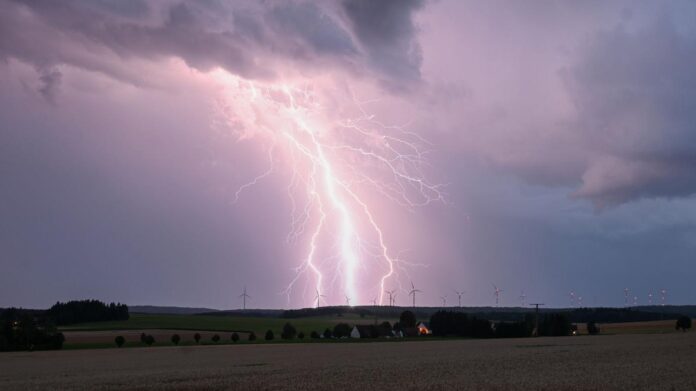
Lightning flashes across the horizon, thunder rumbles and a characteristic smell is in the air: such thunderstorms are typical, especially in summer. But what exactly happens when lightning strikes? How big can they be? And where does thunder come from?
How lightning occurs
Lightning is triggered by an electric field in a thundercloud. In the clouds, the charges separate: the tiny ice crystals become positively charged, the water droplets negatively. The cold upper part of the cloud is then positively charged, the lower part negatively. Finally, the energy is discharged – in a flash of lightning.
This can heat the air to around 30,000 degrees Celsius and reach a length of many kilometers. According to the UN weather organization WMO, the longest lightning bolt ever recorded stretched more than 750 kilometers across the USA.
These discharges can take different forms, with earth discharges between clouds and the ground being considered particularly dangerous. Cloud discharges, on the other hand, remain within a thundercloud and light up the sky. And air discharges are directed into the airspace without reaching the ground.
What dangers arise from lightning strikes
So-called dry lightning strikes between clouds and the ground without rain falling nearby. This type is particularly dangerous because it often causes forest fires, especially after long dry periods. In Germany, dry lightning can occur when the thunderstorm area that normally brings rain does not pass over the location of the strike or leaves only little precipitation.
Not without danger for humans: Lightning can reach a current of more than 100,000 amps, which can lead to burns, paralysis or even cardiac arrest. According to the German Weather Service (DWD), the best place to protect yourself is in solid buildings – or in a car: thanks to the metal body, the lightning current flows outside.
Why the thunder rumbles
The thunder that follows a discharge is the result of the explosive heating of the air in the lightning channel. The extremely high temperatures cause the air there to explode. The air suddenly expands in all directions and creates a pressure wave that races through the surrounding area. Our ears perceive this as loud thunder.
If the lightning channel is at a right angle to the observer, all sound waves arrive at the same time. Then the thunder is a bang. If, however, the lightning channel is inclined towards the person, the pressure waves from the different places in the lightning channel arrive at different times. This creates a continuous rumble of thunder.
To estimate the distance of a lightning bolt, you can use the so-called rule of seconds. While the lightning can be seen almost immediately after it occurs, sound travels about 330 meters per second. If you count the time between the visible discharge and the thunder, you can estimate the distance to the lightning bolt: three seconds correspond to about one kilometer.
Why smell announces rain
Researchers call the smell that hangs in the air during a summer rain petrichor. Two Australians who derived the term in 1964 from the ancient Greek words “petros” (stone) and “ichor” (mythologically the fluid in the veins of the gods) discovered that when rain hits the ground, the water stirs up dust particles that release, among other things, the aroma of an oil that plants produce during drought. The wind disperses these scents, so that you can sometimes smell the rain before it even falls where you are.
The phenomenon can also occur on cold days, but mainly occurs in the summer months. The ground must already be somewhat warm for this to happen, explains the DWD. In principle, this could also happen in the winter months. However, the conditions are met much less frequently here.
© dpa-infocom, dpa:240904-930-222362/1
This is a message directly from the dpa news channel.
